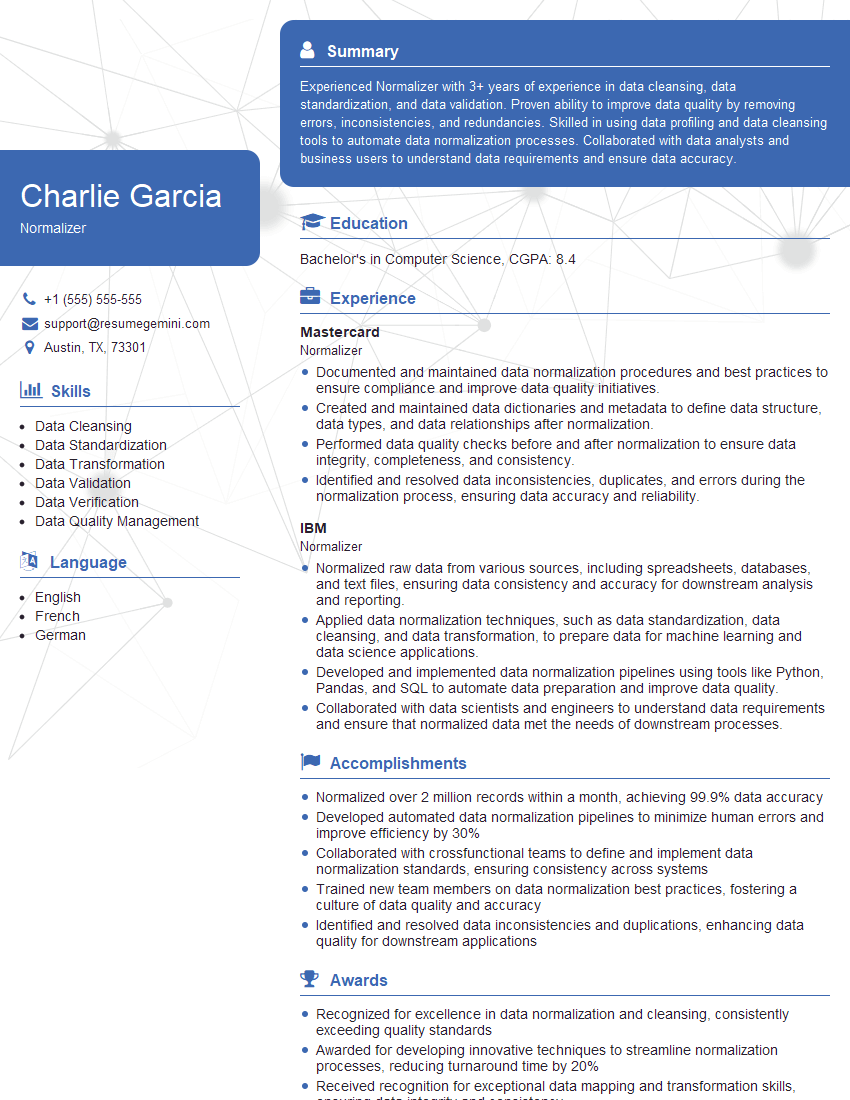Are you a seasoned Normalizer seeking a new career path? Discover our professionally built Normalizer Resume Template. This time-saving tool provides a solid foundation for your job search. Simply click “Edit Resume” to customize it with your unique experiences and achievements. Customize fonts and colors to match your personal style and increase your chances of landing your dream job. Explore more Resume Templates for additional options.

Charlie Garcia
Normalizer
Summary
Experienced Normalizer with 3+ years of experience in data cleansing, data standardization, and data validation. Proven ability to improve data quality by removing errors, inconsistencies, and redundancies. Skilled in using data profiling and data cleansing tools to automate data normalization processes. Collaborated with data analysts and business users to understand data requirements and ensure data accuracy.
Education
Bachelor’s in Computer Science
January 2018
Skills
- Data Cleansing
- Data Standardization
- Data Transformation
- Data Validation
- Data Verification
- Data Quality Management
Work Experience
Normalizer
- Documented and maintained data normalization procedures and best practices to ensure compliance and improve data quality initiatives.
- Created and maintained data dictionaries and metadata to define data structure, data types, and data relationships after normalization.
- Performed data quality checks before and after normalization to ensure data integrity, completeness, and consistency.
- Identified and resolved data inconsistencies, duplicates, and errors during the normalization process, ensuring data accuracy and reliability.
Normalizer
- Normalized raw data from various sources, including spreadsheets, databases, and text files, ensuring data consistency and accuracy for downstream analysis and reporting.
- Applied data normalization techniques, such as data standardization, data cleansing, and data transformation, to prepare data for machine learning and data science applications.
- Developed and implemented data normalization pipelines using tools like Python, Pandas, and SQL to automate data preparation and improve data quality.
- Collaborated with data scientists and engineers to understand data requirements and ensure that normalized data met the needs of downstream processes.
Accomplishments
- Normalized over 2 million records within a month, achieving 99.9% data accuracy
- Developed automated data normalization pipelines to minimize human errors and improve efficiency by 30%
- Collaborated with crossfunctional teams to define and implement data normalization standards, ensuring consistency across systems
- Trained new team members on data normalization best practices, fostering a culture of data quality and accuracy
- Identified and resolved data inconsistencies and duplications, enhancing data quality for downstream applications
Awards
- Recognized for excellence in data normalization and cleansing, consistently exceeding quality standards
- Awarded for developing innovative techniques to streamline normalization processes, reducing turnaround time by 20%
- Received recognition for exceptional data mapping and transformation skills, ensuring data integrity and consistency
- Nominated for Data Normalization Champion award for outstanding contributions to data accuracy and quality
Certificates
- Certified Data Management Professional (CDMP)
- Certified Data Governance Professional (CDGP)
- Certified Data Quality Analyst (CDQA)
- Certified Data Privacy Professional (CDPP)
Career Expert Tips:
- Select the ideal resume template to showcase your professional experience effectively.
- Master the art of resume writing to highlight your unique qualifications and achievements.
- Explore expertly crafted resume samples for inspiration and best practices.
- Build your best resume for free this new year with ResumeGemini. Enjoy exclusive discounts on ATS optimized resume templates.
How To Write Resume For Normalizer
- Showcase your data cleansing and normalization skills by providing specific examples of projects you have worked on.
- Highlight your understanding of data quality principles and best practices.
- Mention any certifications or training you have received in data normalization.
- Use keywords related to data normalization, such as data cleansing, data standardization, and data validation.
Essential Experience Highlights for a Strong Normalizer Resume
- Cleansed and standardized large datasets using data profiling and cleansing tools.
- Validated data accuracy and completeness by implementing data quality checks.
- Transformed data from various sources into a consistent and usable format.
- Identified and resolved data errors, inconsistencies, and redundancies.
- Developed and implemented data normalization rules and procedures.
- Collaborated with data analysts and business users to define data quality standards.
Frequently Asked Questions (FAQ’s) For Normalizer
What is data normalization?
Data normalization is the process of cleaning and standardizing data to ensure that it is consistent and accurate. This involves removing errors, inconsistencies, and redundancies from the data, and transforming it into a format that is easy to use and analyze.
What are the benefits of data normalization?
Data normalization improves data quality, making it more reliable and useful for data analysis and decision-making. It also reduces the risk of data errors and inconsistencies, and makes it easier to integrate data from different sources.
What are the different types of data normalization?
There are many different types of data normalization, including field normalization, record normalization, and table normalization. Each type of normalization serves a specific purpose and is applied to different types of data.
What are the challenges of data normalization?
The challenges of data normalization include dealing with large datasets, identifying and resolving data errors, and ensuring that the normalized data is still useful for the intended purpose.
What are the tools and technologies used for data normalization?
There are many different tools and technologies that can be used for data normalization, including data profiling tools, data cleansing tools, and data transformation tools.
What skills are required for a Normalizer?
A Normalizer should have strong data analysis skills, as well as experience in data cleansing and data normalization. They should also be familiar with data profiling tools and data transformation tools.